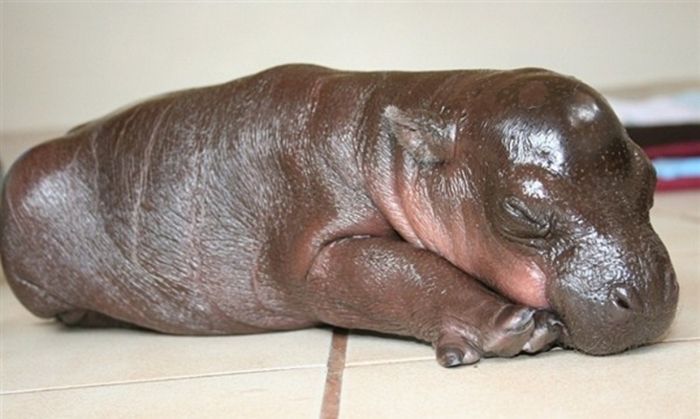|
|
6-day-old Baby Hippopotamus Calf
|
Hippos measure 3.3 to 5.2 meters (11 to 17 ft) long, including a tail of about 56 centimeters (22 in) in length and average about 1.5 meters (5 ft) tall at the shoulder. The range of hippopotamus sizes overlaps with the range of the White Rhinoceros; use of different metrics makes it unclear which is the largest land animal after elephants. Even though they are bulky animals, hippopotamuses can run faster than a human on land. Estimates of their running speed vary from 30 km/h (18 mph) to 40 km/h (25 mph), or even 50 km/h (30 mph). The hippo can maintain these higher speeds for only a few hundred meters.
A hippo's lifespan is typically 40 to 50 years. Donna the Hippo, 57, is the oldest living hippo in captivity. She lives at the Mesker Park Zoo in Evansville, Indiana. The oldest hippo ever recorded was called Tanga; she lived in Munich, Germany, and died in 1995 at the age of 61.
The eyes, ears, and nostrils of hippos are placed high on the roof of the skull. This allows them to be in the water with most of their body submerged in the waters and mud of tropical rivers to stay cool and prevent sunburn. Their skeletal structure is graviportal, adapted to carrying the animals' enormous weight. Hippopotamuses have small legs (relative to other megafauna) because the water in which they live reduces the weight burden. Unlike most other semi-aquatic animals, the hippopotamus has very little hair.
Their skin secretes a natural sunscreen substance which is red-colored. The secretion is sometimes referred to as "blood sweat," but is neither blood nor sweat. This secretion is initially colorless and turns red-orange within minutes, eventually becoming brown. Two distinct pigments have been identified in the secretions, one red (hipposudoric acid) and one orange (norhipposudoric acid). The two pigments are highly acidic compounds. Both pigments inhibit the growth of disease-causing bacteria; as well, the light absorption of both pigments peaks in the ultraviolet range, creating a sunscreen effect. All hippos, even those with different diets, secrete the pigments, so it does not appear that food is the source of the pigments. Instead, the animals may synthesize the pigments from precursors such as the amino acid tyrosine.
|
|









